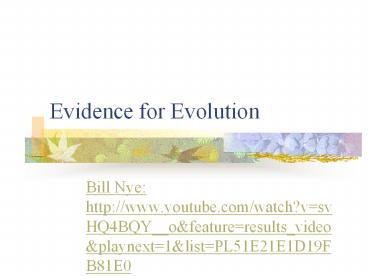Evidence for Evolution - PowerPoint PPT Presentation
Title:
Evidence for Evolution
Description:
Title: Evidence for Evolution Author: Melissa K. Heineman Last modified by: Melissa Jenkins Created Date: 9/30/2003 12:35:27 AM Document presentation format – PowerPoint PPT presentation
Number of Views:295
Avg rating:3.0/5.0
Title: Evidence for Evolution
1
Evidence for Evolution
- Bill Nye http//www.youtube.com/watch?vsvHQ4BQY_
_ofeatureresults_videoplaynext1listPL51E21E1
D19FB81E0
2
Major Evidence for Evolution
- Fossil record
- Homologous structures
- Vestigial structures
- Biochemical evidence
- Embryological development
3
Charles Darwin
- 1859 Origin of Species published
- Argued from evidence that species inhabiting
Earth today descended from ancestral species - Proposed a mechanism for evolution ? Natural
Selection - Many scientists helped pave the way for Darwins
Theory
4
(No Transcript)
5
(No Transcript)
6
Theory of Evolution By Natural Selection
- In each generation of a species, individuals have
slight differences. - Sometimes these variations make an individual
more successful in its environment
7
- (more food, live longer, reproduce more, attract
better mates). Then individual may then
reproduce and pass this variation on to its
offspring. - Then the individual may reproduce and pass this
variation on to its offspring.
8
Natural Selection
- Variations in individuals are controlled by
genes. - Individuals have no control over what variations
they will have.
9
- Useful variations are NOT ALWAYS passed on.
- Variations that are not useful may also be passed
on.
10
Alfred Russel Wallace
- co-discovered natural selection and prompted
Darwin to finally rush his Origin of Species to
press. - One of the modern worlds greatest scientific
adventurer explorers - eight-year exploration of Southeast Asia and the
Malay Archipelago he wrote The Malay Archipelago
in 1869, - Geographical Distribution of Animals (1876) is
one of the seminal works in the field. - the workhorse of Darwinian evolution, diverged
from Darwins methodological naturalism (i.e.,
the notion that scientists must invoke only
natural processes functioning via unbroken
natural laws in nonteleological ways) to propose
a theory of evolution defined by intelligence and
design.
11
Jean Lamarck
12
1. Fossil Record
- What does the Fossil Record tell us about
organisms? - Looks (size, shape, etc.)
- Where or how they lived
- What other organisms they lived with
13
- What time period they lived in (based on location
in rock layers) - What order living things came in (based on
location in rock layers) - Transitional forms
- Organisms that were intermediate (between) two
other major organisms
14
Example Horse
15
(No Transcript)
16
- Homologous Structures-bodily structures that are
similar in structure, but different in function,
due to sharing a common ancestor
17
2. Homologous Structures
18
Homologous Structures
19
Analogous Structures
- Analogous structures- bodily structures that are
similar in function, but not in structure. NOT
EVIDENCE OF COMMON ANCESTRY. - Example wings of a bee and wings of a bird
20
(No Transcript)
21
3. Vestigial Structures
- Structures that serve no function but useful
structures in earlier ancestors - Examples Ear muscles
- Human tailbone
- Appendix
22
(No Transcript)
23
(No Transcript)
24
Vestigial Organs
25
4. Embryological Development
- Embryo- fertilized egg that will/is in the
process of growing into a new individual - Closely related organisms go through similar
developmental stages early in development - All vertebrates have gill pouches sometime during
their early development
26
(No Transcript)
27
5. Molecular/Biochemical Evidence
- DNA used to translate nucleotide sequences into
amino acid is essentially the same in all
organisms - Proteins in all organisms are composed of the
same set of 20 amino acids - Powerful argument in favor of the common descent
of the most diverse organisms.
28
Universal Code
29
Biochemical Compound Ex
- DNA
- Cyt C
- 20 amino acids
- Some enzymes
30
Molecular/Biochemical Evidence
- Cytochrome c
- An ancient protein common to all aerobic (oxygen
breathing) organisms - Amino acid sequence to make cytochrome c differs
increasingly the more distantly related two
organisms are (very similar amino acid sequence
closely related) - The cytochrome c of humans and chimpanzees is
identical
31
DNA
Cyt C































